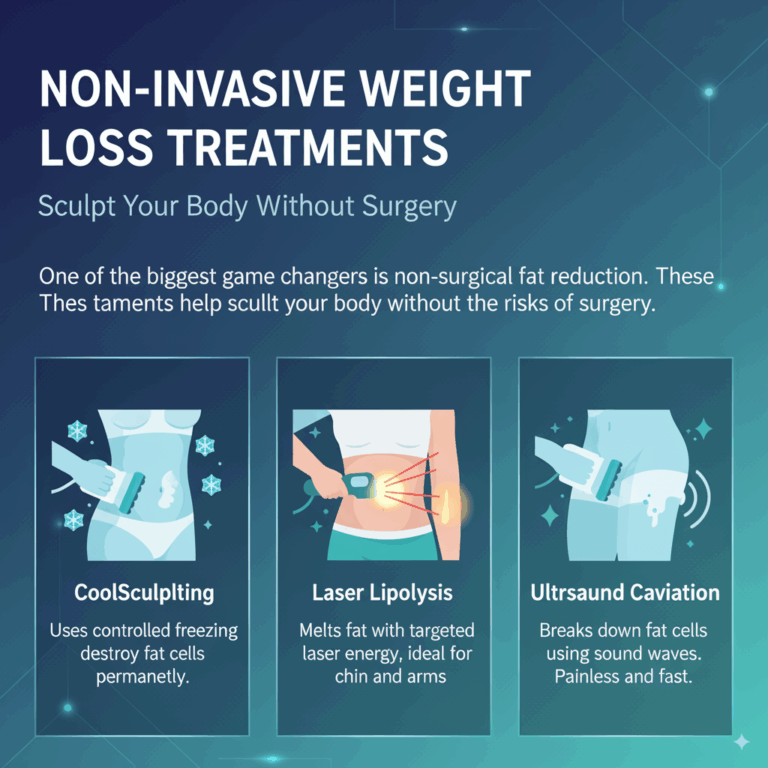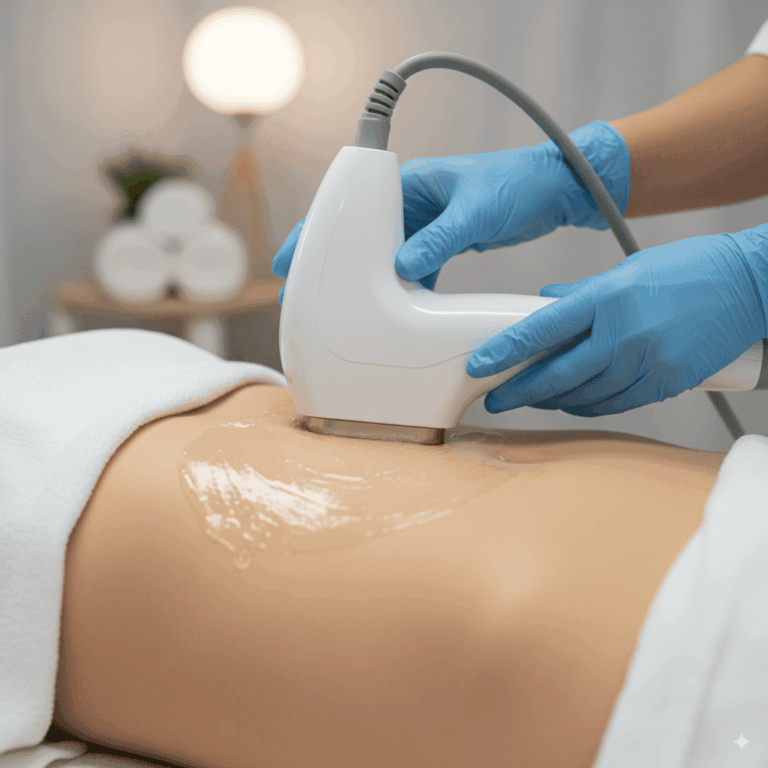The Physics and Physiology of Advanced Body Contouring: A Technical Overview
The field of aesthetic medicine has undergone a profound transformation over the last two decades. Where surgical intervention was once the only viable path to significant body contouring, a new era defined by advanced, energy-based devices has emerged. These non-invasive technologies leverage fundamental principles of physics—thermodynamics, acoustics, and electromagnetism—to elicit specific and predictable physiological responses within human tissue. This article provides a technical deconstruction of the core technologies that power modern multi-modality body contouring platforms, exploring the science behind how they achieve fat reduction and dermal tightening without a single incision.
The Paradigm Shift: From Scalpel to Energy-Based Devices
The transition away from invasive procedures like surgical liposuction is driven by a demand for effective treatments with minimal downtime, reduced risk, and no scarring. The solution lies in energy-based systems capable of selectively targeting and altering specific cellular structures while leaving surrounding tissues unharmed. The primary target in body contouring is the subcutaneous fat cell, or adipocyte.
Understanding the Target: The Subcutaneous Adipocyte
Subcutaneous adipocytes are highly specialized cells primarily composed of a large lipid droplet containing stored triglycerides. Their unique composition and structure make them vulnerable to various forms of energy in ways that other cells—such as dermal fibroblasts, keratinocytes, or nerve cells—are not. Understanding this differential vulnerability is the key to all non-invasive body contouring. The goal is to introduce an energy source that will either destroy the adipocyte (inducing apoptosis or necrosis) or compel it to release its contents (lipolysis), all while preserving the integrity of the overlying epidermis and underlying dermis.
Modality 1: Cryolipolysis – Selective Apoptosis Through Controlled Cooling

Cryolipolysis, colloquially known as “fat freezing,” is a non-surgical fat-reduction procedure that uses controlled cooling to eliminate stubborn fat. The technology is built on the scientific principle that adipocytes are more susceptible to cold-induced injury than other cell types.
The Core Principle: Lipid Crystallization and Apoptosis
The mechanism of action is rooted in thermodynamics. When subcutaneous tissue is cooled to temperatures between approximately -10°C and +4°C, the highly saturated fatty acids within the adipocytes begin to crystallize at a higher temperature than the water within other cells. This crystallization process creates an irreversible physical stress on the cell’s membrane and internal organelles.
This event triggers apoptosis, a natural, controlled process of programmed cell death. Unlike necrosis (traumatic cell death), apoptosis does not provoke a significant inflammatory response. Over the subsequent weeks and months, the body’s immune system recognizes these apoptotic cells as debris. Macrophages, the phagocytic “clean-up” cells of the body, engulf and digest the compromised adipocytes. The lipids and cellular remnants are then transported via the lymphatic system to the liver for processing and are eventually excreted from the body. This gradual elimination results in a measurable reduction of the fat layer in the treated area.
Technological Evolution: From Plate Cooling to 360° Surround Applicators
Early cryolipolysis devices utilized applicators with two flat cooling plates. While effective, this design inherently creates a non-uniform cooling profile, with the most intense cooling occurring nearest the plates and a less-cooled zone in the center of the drawn tissue.
Advanced systems have overcome this limitation with the development of 360° surround cooling applicators. These applicators feature a cooling element that lines the entire interior surface of the treatment cup. This engineering improvement ensures that the entire volume of tissue drawn into the applicator is cooled to the target therapeutic temperature uniformly and efficiently. The technical advantages are significant:
- Enhanced Efficacy: A larger percentage of adipocytes within the treatment zone are successfully brought to the point of crystallization.
- Improved Treatment Efficiency: Uniform cooling can reduce treatment times while potentially increasing the percentage of fat cells affected per session.
- Superior Conformity: These applicators are often constructed from flexible materials like medical-grade silicone, allowing for better adherence to the body’s natural contours.
Furthermore, some advanced protocols incorporate a preliminary heating phase (e.g., to ~45°C) just before the cooling cycle. This thermal shock is believed to enhance efficacy by increasing local blood flow, which then vacates the area as vasoconstriction sets in during the cooling phase, allowing for more efficient cooling of the fat itself.
Modality 2: Acoustic Lipolysis via Ultrasonic Cavitation
Ultrasonic cavitation is a body contouring technology that uses low-frequency ultrasound waves to break down fat cells. The term “cavitation” refers to the formation of vapor-filled cavities, or bubbles, in a liquid—in this case, the interstitial fluid surrounding the adipocytes.

The Mechanics of 40KHz Ultrasonic Cavitation
High-power, low-frequency ultrasound (typically around 40 kHz) is transmitted into the adipose tissue via a handpiece. This acoustic energy generates cycles of high and low pressure, causing microscopic bubbles to form within the interstitial fluid. These bubbles oscillate in size as they are subjected to the alternating pressure waves.
Inertial Cavitation and Adipocyte Disruption
At the 40 kHz frequency, the process leads to a phenomenon known as “inertial” or “transient” cavitation. The bubbles expand and contract rapidly over several cycles until they reach a critical size where they can no longer absorb energy. At this point, they violently collapse, or implode. This implosion creates a powerful shockwave and localized, high-temperature micro-jets. The immense mechanical force generated by this shockwave is sufficient to rupture the relatively fragile membranes of the nearby adipocytes, while more resilient structures like blood vessels, nerves, and connective tissue remain intact.
Once the adipocyte membrane is breached, the stored triglycerides are released into the interstitial space. These triglycerides are then broken down into free fatty acids and glycerol, which are subsequently absorbed by the lymphatic system and transported to the liver. The liver does not distinguish between fatty acids from cavitation and those from a meal, processing them through normal metabolic pathways.
Modality 3: Dermal Remodeling with Radio Frequency (RF) Energy
A common consequence of fat volume reduction is potential skin laxity. Radio Frequency (RF) technology is the gold standard for non-invasive skin tightening and is a critical component of a comprehensive body contouring platform.

Volumetric Heating and Neocollagenesis
RF energy is a form of electromagnetic radiation. When applied to the skin, it travels through the tissue, and its path of least resistance is through the hydrated dermal layers. The tissue’s natural impedance to this current flow generates precise and controlled heat deep within the dermis. This is known as volumetric dermal heating.
This thermal effect is twofold:
- Immediate Collagen Contraction: The heat causes the existing triple-helix structure of collagen fibers to denature and contract. This provides an immediate, albeit modest, tightening effect.
- Delayed Neocollagenesis: The more significant, long-term effect is a wound-healing response. The controlled thermal “injury” stimulates dermal fibroblasts—the cells responsible for producing collagen and elastin. Over the weeks and months following treatment, these activated fibroblasts produce new, healthy, and well-organized collagen fibers (neocollagenesis) and elastin (neoelastogenesis), resulting in firmer, tighter, and thicker skin.
The Importance of Applicator Configuration: Face vs. Body
RF devices are available in monopolar, bipolar, and multipolar configurations. Multipolar applicators, which contain multiple electrodes, are particularly effective as they create a dense, uniform heating matrix at various depths. Advanced platforms provide different applicators for the face and body. Facial applicators are smaller with a more concentrated electrode pattern to safely treat delicate areas, while body applicators are larger to cover more surface area efficiently and deliver energy to the thicker dermal tissue of the abdomen, thighs, and arms.
Modality 4: Photobiomodulation via Low-Level Laser Therapy (LLLT)
Also known as Lipo Laser, this modality offers a gentler, purely lipolytic approach to fat reduction, meaning it causes fat cells to release their contents without causing cell death.

Creating Transient Porosity in Adipocyte Membranes
LLLT uses diodes that emit laser energy at a specific wavelength (typically in the 635-650 nm red light spectrum). This light energy penetrates the skin to the subcutaneous adipose layer. The photochemical and photobiological effect is believed to create temporary, microscopic pores in the membrane of the adipocytes.
This transient porosity allows the stored triglycerides to be broken down (lipolysis) and to pass through the membrane into the interstitial space. The adipocyte itself is not destroyed; it is simply emptied, leading to a reduction in its size and a corresponding loss of inches in the treated area. The released lipids are then cleared by the lymphatic system for metabolic use.
The Synergistic Advantage: Multi-Modality Platforms for Enhanced Outcomes
The true power of modern body contouring lies in the intelligent combination of these technologies. A single-modality approach can be limiting. Cryolipolysis is excellent for debulking significant fat pockets, but may not address skin texture. Cavitation excels at treating more fibrous adipose tissue. RF is essential for addressing the skin laxity that can result from volume loss.
A Hypothetical Integrated Treatment Protocol
A comprehensive treatment plan might involve using cryolipolysis to address the primary area of concern. In subsequent sessions, cavitation could be used to smooth the contours and break up any remaining irregularities. Each of these sessions could be concluded with an RF treatment to promote dermal tightening, ensuring that as the fat layer shrinks, the overlying skin remains firm and taut. LLLT might be used between major sessions or on different body areas to promote overall circumferential reduction. This synergistic approach allows practitioners to create highly customized protocols that address a patient’s full spectrum of contouring needs, leading to superior clinical outcomes.
Conclusion: The Convergence of Physics and Biology in Modern Aesthetics
Non-invasive body contouring is a testament to the power of applied science. By harnessing controlled cooling, acoustic shockwaves, electromagnetic heating, and specific wavelengths of light, these advanced platforms can precisely manipulate biological processes at the cellular level. They induce apoptosis, provoke lipolysis, and stimulate neocollagenesis with a high degree of safety and predictability. The future of the field lies in the continued refinement of these energy-delivery systems and the further integration of modalities into intelligent platforms that offer comprehensive, customized solutions for the age-old pursuit of the ideal physique.
Frequently Asked Questions (FAQs)
1. What is the fundamental difference between fat reduction via apoptosis (Cryolipolysis) and lipolysis (LLLT)? Apoptosis, induced by cryolipolysis, is a process of programmed cell death. The targeted fat cell is permanently and irreversibly eliminated from the body. Lipolysis, induced by LLLT, is the process where a fat cell releases its stored lipid contents but remains alive and intact, albeit in a shrunken state. It can theoretically store fat again in the future.
2. How is the safety of surrounding tissue (skin, nerves) ensured during Cryolipolysis? Safety is ensured by the different freezing points of various tissues. The lipids in fat cells crystallize at a higher temperature (around 0-4°C) than the water in skin, nerve, and muscle cells (below 0°C). The technology carefully controls the temperature to remain within a therapeutic window that is cold enough to trigger fat cell apoptosis but not cold enough to damage the surrounding, more water-dense tissues. Integrated sensors constantly monitor skin temperature as a failsafe.
3. Why do Ultrasonic Cavitation and Radio Frequency use such different frequencies? They operate on different physical principles to achieve different goals. 40 KHz ultrasound for cavitation is a mechanical wave used to create the physical phenomenon of bubble implosion to destroy cells. Radio Frequency (typically 1-10 MHz) is an electromagnetic wave used to generate heat within the tissue by overcoming its electrical impedance. The higher frequency of RF is optimal for creating controlled, deep dermal heating for collagen remodeling, whereas the lower frequency of ultrasound is ideal for generating the large cavitation bubbles needed for acoustic lipolysis.
4. What is the role of the lymphatic system in all these treatments? The lymphatic system is the body’s natural drainage and filtration network, and it is critically important for all of these modalities. After adipocytes are destroyed (Cryolipolysis, Cavitation) or their contents are released (LLLT), the resulting lipids and cellular debris are cleared from the interstitial space by the lymphatic vessels. This material is then transported to lymph nodes for filtering and eventually to the liver for metabolic processing and excretion. Proper hydration and light physical activity can help optimize lymphatic function and enhance results.
5. Is it technically sound to combine these energy-based technologies in a single treatment session? Yes, it is not only technically sound but often clinically advantageous. A common and effective protocol is to perform a fat reduction modality (like cavitation) followed immediately by a skin tightening modality (like RF) in the same area. The cavitation disrupts the fat cells, and the RF helps to tighten the skin in the newly de-volumized area, addressing both concerns simultaneously. However, combining two potent fat-destructive modalities like Cryolipolysis and Cavitation on the exact same area in the same session is generally not recommended and protocols typically space them out.



